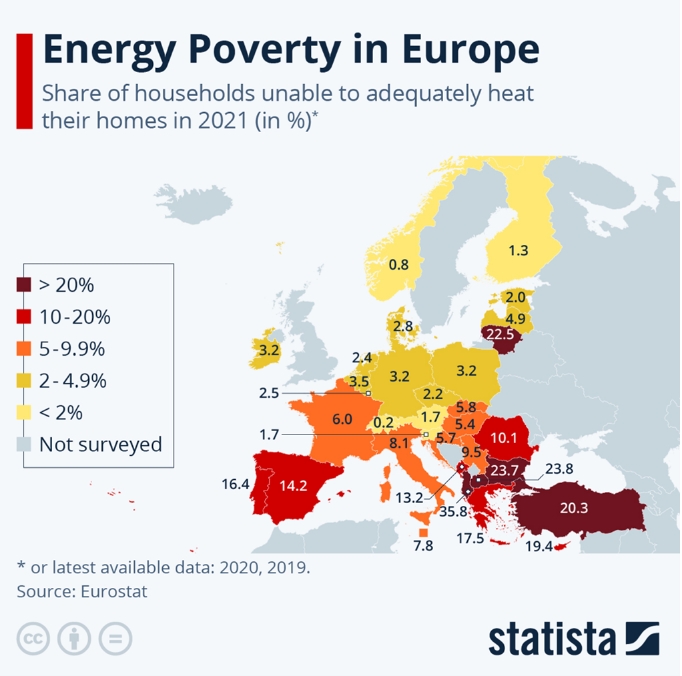What is the global response to the dramatic rise in “energy poverty”?
Last year, Europe managed to survive a worrying winter without large-scale energy shortages or power cuts. Although this came at a cost, it demonstrated Europe’s considerable resilience.
Between September 2021 and March 2023, EU member states reportedly allocated €646 billion to protect consumers from rising energy costs.
Now that winter is coming to Europe, on November 20, the European Commission adopted an amendment to the Temporary Crisis and Transition Framework for State Aid. According to the bill, EU member states can maintain their subsidy programs until June 30, 2024, to cope with the winter heating season.
The European Commission also allowed an increase in the subsidy ceiling, which was raised from €250,000 to €280,000 for the agriculture sector, from €300,000 to €335,000 for the fisheries and aquaculture sector, and from €2 million to €2.25 million for all other sectors.
To analysts, the EU’s move shows that it is still worried about current energy supplies. Despite the EU’s efforts to cut costs over the past year, it is feared that it will take longer to achieve energy self-sufficiency.

Source: Eurostat Graphic: Household Consumer Electricity Prices in the EU (taxed and untaxed)
Despite government subsidies, it is still not possible for European residents to pay high energy bills. In the UK, for example, the 2022 Russia-Ukraine war will lead to a spike in gas prices, with the average UK citizen paying £3,549 per household per year, leaving up to 7 million households in ‘energy poverty.’
Outside of the UK, 9.3% of EU citizens will be in energy poverty, i.e., unable to afford a comfortable indoor temperature, in 2022, up from 6.9% in 2021.
Energy poverty refers to the inability of an individual or household to access or pay for the energy services they need to meet their basic living needs, such as cooking, heating and lighting.
In fact, energy poverty is a problem in Europe and other countries or regions. In the United States, it is estimated that 16% of the region experiences energy poverty, including 5.2 million households considered to be above the federal poverty line. In China, it is estimated that 24-27% of middle-aged and older adults live in energy poverty.
Therefore, in the context of the global net-zero transition, the importance of this should not be limited to technological development but also to ensure that all groups in society can meet their energy needs without impacting their daily lives.
Energy poverty jeopardizes physical and mental health.
According to the United Nations Sustainable Development Report 2022, in 2020, 733 million people worldwide will still lack access to stable electricity. The term “energy” also covers electricity, transportation, and household fuels.
In fact, energy poverty is not just about not being able to pay the electricity bill but is intertwined with the characteristics of women, income, age, health factors, etc. The multiple dilemmas that make energy poverty are not only about energy but also related to various social factors such as health and the right to housing.
For example, living in a house that lacks insulation and warmth means relying on heating to get through the winter, but the rising cost of electricity makes it even more burdensome for energy-poor households to endure the cold and not use the heating as much as possible.
Scientific studies have shown that cold houses are harmful and sometimes fatal to their occupants. People are at higher risk of stroke, respiratory infections and, falls or other injuries due to reduced strength and flexibility in cold temperatures. A cold home can have both short- and long-term effects on a person’s health, well-being, and even life chances.
A 2018 long-term study of 30 European countries, from 1980 to 2013, noted that people in the UK had the sixth highest excess winter mortality rate; and the UK was second highest in deaths related to whether or not heating was supplied to the family home. If the energy crisis does not improve, cold-induced deaths will create a significant demand for healthcare.
Information released by the Office for National Statistics in December 2022 suggests that more people will die in the UK from cold in 2022 than from heat in the summer compared to the previous year.
How is the world responding?
In response, many countries and cities have introduced different measures aimed at saving energy and reducing carbon emissions in an attempt to tackle energy poverty while moving towards net-zero carbon emissions. In many cases, energy-saving and energy-efficient home appliances are being used to help these already poor households reduce their electricity bills.
01|Belgium: Appliance Sharing for Low-Income Households
The Belgian government, in cooperation with home appliance manufacturers, has launched a “home appliance sharing” program, in which low-income eligible people can participate. With a monthly expenditure of just 7 euros, they can use appliances with the highest energy efficiency of A+++ for a period of up to 10 years, and maintenance and repair services are also provided.
02|Kumagaya City, Japan: Air-conditioning Rental Program for the Elderly
Kumagaya City in Japan, where middle-aged and elderly people account for 60% of summer heatstroke cases, is promoting the “Air Conditioning Rental Program for the Elderly” from 2021, which offers air conditioning rentals without installation fees for 1,900 yen per month, and the air conditioning will be returned to the user after five years of use.
03|Ithaca, New York: Decarbonizing homes to save on energy costs
Ithaca, New York, USA, where about 40% of the population is at the energy poverty line, has partnered with start-up BlocPower in 2022 to replace existing heating and cooling systems in buildings with technologies such as heat pumps or solar panels to improve the city’s energy efficiency. With the improved equipment, residents will no longer have to worry about increased heating costs due to changes in oil prices and can save between 20 and 40 percent on energy costs over a year.


